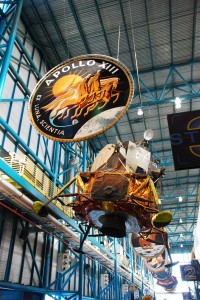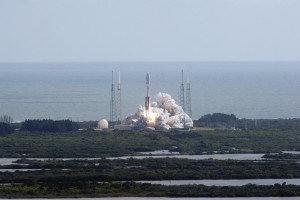
Liftoff of the ULA Atlas V rocket carrying Mars Science Laboratory. Photo credit: JR
As I’m sure anyone with any interest in the subject has heard by now, NASA celebrated a successful launch of the Mars Science Laboratory (Curiosity rover) Saturday at 10:02:00.211 a.m. EST. I was fortunate enough to be able to attend the launch, as well as several pre-launch presentations/Q&As and gatherings, as part of a NASA Tweetup. I haven’t sorted through all my photos, much less all my thoughts, but as my mind and life return to normal, I’ll be taking using this website to store some of my impressions of the experience.
I’ll have more to say about the Tweetup later, but let me start with the topic of the Kennedy Space Center Visitors Complex (KSCVC).

Apollo Lunar Module (LM-9, unused) at Saturn V Center, KSCVC. Photo credit: JR
I took two different tours of the KSCVC—the first, the standard bus tour that comes with the price of admission, the second, a more extended tour with the NASA Tweetup group that included part of the Cape Canaveral Air Force Station. My lingering impression is this: Kennedy Space Center, along with the rest of the NASA-affiliated sections of the space program, is trying to work through a rather ambiguous moment in space history. The Space Shuttle program is over; Constellation was cancelled; the U.S. National Space Policy is in its infancy; current launches (like the Mars Science Laboratory or the upcoming Space X launch) are all unmanned; the launches are taking place on the Air Force Station rather than Kennedy Space Center… Perhaps because of these factors, my tour guides were having difficulty locating the ever-shifting line between past, present and future.
For instance, the parts of NASA’s story that are clearly history, like the Apollo fire and the lunar landing, had a clear narrative in the interpretive signage/docent talks. There was a strong thread tying together Cold War patriotism, heroic sacrifice, daring fly-by-the-seat-of-our-pants engineering, American technological superiority, and the human will to conquer (space and everything else). That thread began to unravel when it came to the Space Shuttle program, though. The Challenger and Columbia tragedies, and the measures taken afterward to prevent them from happening again, folded fairly neatly into the master narrative of U.S. space history. The end of the Space Shuttle program, however, was a little more tricky. My guides kept slipping from past tense to present and then back again, “This is where we stack the Shuttles…*stacked* the Shuttles.” “We launch, uh, used to launch, from 39A…”
I think people are still in denial, or even shock, that the end of the Shuttle program is actually here. That end came so recently (the final Space Shuttle mission, STS-135, was in July 2011) it’s easy to forget that another mission isn’t just around the corner. But I think real cause of the slippage is that there isn’t a clear path forward from here in terms of manned missions. While NASA is involved in many different space exploration initiatives, Kennedy Space Center derives a large part of its identity from manned launches.

Launch Complex 39A, Kennedy Space Center. Photo credit: JR
The photo above shows LC-39A, the last launch pad to be used for the Space Shuttle program. So far, it’s been left intact. I heard various explanations for this decision, some of which emphasized practicality (“We don’t know what we’ll need in future, so it doesn’t make sense to take it down if we might have to put it all back up again”), some of which highlighted something closer to nostalgia (“It’s symbolic, to remind us and visitors of what we accomplished with the Shuttle”). The truth probably falls somewhere in between—NASA can’t spare the money to break down what doesn’t need to be broken, so what’s the harm is letting it do some emotional work for us?
There’s a certain longing for manned space flight among NASA and its supporters. So many of the presentations I heard during the Tweetup framed the Mars Science Laboratory in terms of future manned exploration, as if that is the natural procession of science, and the only reason to fly unmanned missions (first we do a fly-by, then we do an orbit insertion, then we land a rover, then we manage a sample return, and then we send humans!). I’ll have more to say about that later. For now, I’ll just leave it at: I wonder what is lost/gained when we approach missions as part of a chain that culminates in human travel? How would the discussion change if we considered unmanned exploration as an end instead of a means?







